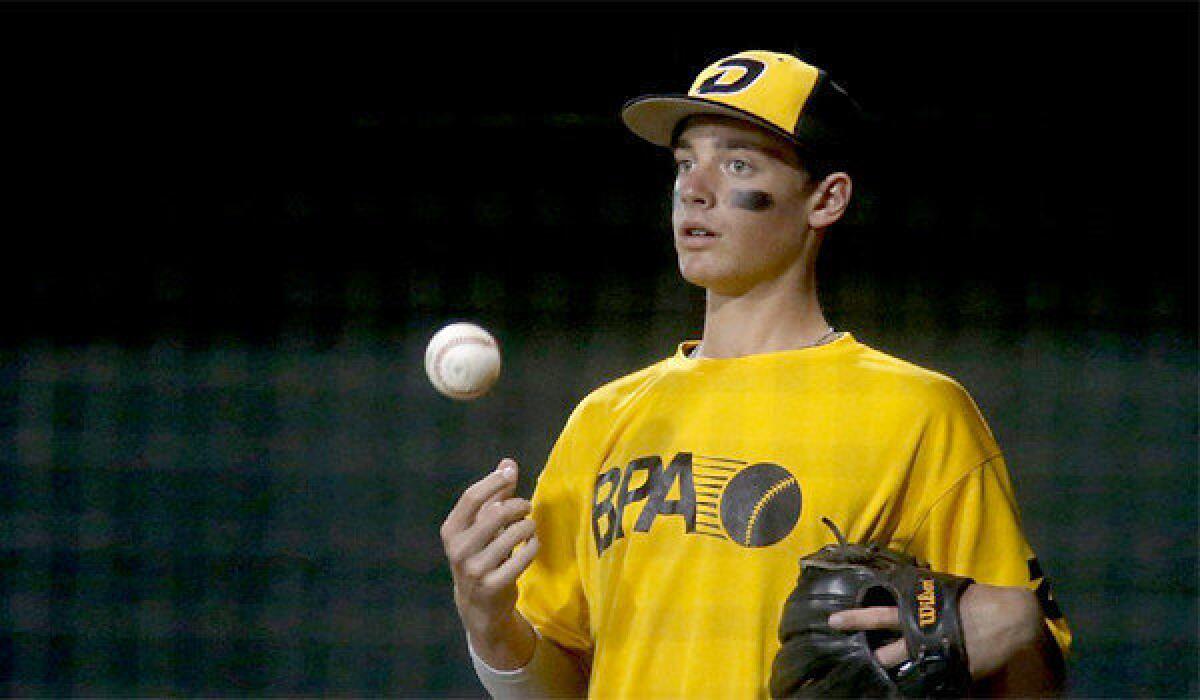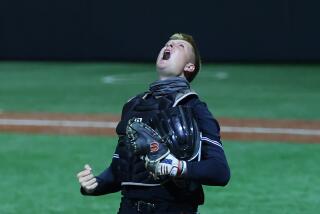Youth is being served in recruitment of baseball players by colleges

- Share via
It was no surprise when the baseball world began watching Hagen Danner more closely.
After helping his Huntington Beach team to the 2011 Little League World Series title, Danner continued to excel in youth tournaments, showing a strong arm and smooth swing.
Still, he was taken aback when UCLA Coach John Savage offered him an athletic scholarship over the summer.
“I had no idea what was going on,” he said. “Coach Savage had to explain it.”
The reason for Danner’s confusion? He was only 14 and had yet to play an inning of high school ball.
Early commitments are nothing new to college football and basketball. The practice has become more common since 2010, when former USC coach Lane Kiffin made headlines by pursuing a 13-year-old quarterback.
But until recently, other sports had followed a traditional path, with no heavy recruiting push until prospects reached their junior or senior year in high school.
Now, it seems, the rush for young talent is spreading to baseball.
Within the last year, a handful of Southern California ballplayers, including Nick Pratto, Mickey Moniak, Chase Strumpf, Nick Allen and Christian Moya, have committed early. Very early.
These boys aren’t even old enough to formally accept an offer. Under NCAA rules, they must wait until the fall of their senior year to sign a national letter of intent.
In the meantime, the most they can do is make an oral commitment — an unofficial promise — to sign three or four years down the road. Moniak and Strumpf plan to join Danner at UCLA. Pratto, Allen and Moya say they are headed to USC.
“If you would have come to me a year ago and posed this whole scenario, I wouldn’t have believed it,” said Jeff Pratto, Nick’s father. “There’s just no way.”
This budding phenomenon is difficult to measure because no one keeps a full accounting of oral commitments. It has certainly become a topic of discussion among coaches and people who follow high school baseball.
“As soon as one coach does it and sets the precedent, everyone else follows suit to maintain the competitive balance,” said Clint Longenecker, an assistant editor at Baseball America.
Longenecker heard talk about early commitments at a recent Arizona event, which should be no surprise — the rise of travel teams could be fueling a trend.
More and more frequently, top-notch players leave their neighborhood youth leagues to join squads that play in tournaments and showcases around the country. College recruiters can see all the best talent in one place.
Pratto is a good example. This summer, the 14-year-old pitcher outdueled an older batter and big-time college recruit in a Central California tournament. Then he traveled to North Carolina and — like Allen, Moniak, Strumpf and Moya — made the national 15-under national team.
“I started getting letters from colleges,” he said. “They watched me play.”
NCAA rules prohibit recruiters from emailing a prospect until the start of his junior year or calling him until the next summer, but he is free to contact them at any time. USC’s Dan Hubbs sent word through Pratto’s travel team.
“My coach told me that USC wanted me to call,” the player said. “So I called.”
The same thing happened with Danner and Moniak who, like Pratto, visited several campuses.
Said Matt, Mickey’s father: “I was surprised they’d want a commitment so early.”
Coaches claim they are not entirely comfortable with the process. Savage said, “Kids are faced with a big decision at such a young age, but if we want to get the best players, we have to get involved with them very early.”
When assessing an eighth-grader, recruiters must project his development years into the future. Hitting, throwing and running are only part of the equation.
Recruiters look at his hands and feet to estimate how much he will grow. They talk to his family to gauge his maturity. With few or no high school transcripts to consider, and no SAT scores, they can only guess at his abilities in the classroom.
“That’s a huge concern,” Longenecker said. “They don’t really know if a player has a realistic shot at being able to enroll.”
Because only the best players in the nation get recruited so young, coaches worry about expending time and effort on someone who will end up jumping straight from high school to professional baseball.
“They asked both me and my wife about our degrees and our beliefs in getting a college education,” Scott Danner said. “We told them it was very important to us.”
Assurances go only so far. Said Hubbs: “You think a kid is for sure going to school but then someone drafts him and gives him $700,000.”
There is one more complication with early commitments: Nothing is written in stone. The NCAA does not even recognize oral commitments.
In football and basketball, recruiting has turned into the Wild West, with prospects continuing to visit schools after orally accepting an offer. They sometimes change their minds at the last moment. Baseball could be headed that way.
“Eight years ago, no one de-committed,” Hubbs said. “Now you’re starting to see more.”
As for schools backing out of a deal, the tight-knit nature of the baseball community helps maintain order. Even when a promising 14-year-old fails to develop into a star 17-year-old, college coaches worry about withdrawing an offer.
“You do that enough and you’re going to get a reputation,” Hubbs said. “You’ll get high school coaches who don’t want to send their players to you.”
Savage insists that UCLA will not renege unless a prospect runs afoul of the law or fails to qualify academically. He said the Bruins will honor commitments even in cases of significant injury.
But that puts colleges at greater risk of making mistakes with limited resources. They are allowed only 11.7 scholarships to spread in partial offers among 25 or more players.
The Pratto and Danner families declined to specify the value of their offers, but said they were close to 100%. Others receive only half- or quarter-scholarships.
The trend toward early commitments might have negative effects on high school teams where young players might not be as motivated to practice and play hard.
“We really push that,” said Brett Kay, Strumpf’s coach at JSerra High. “You don’t want complacency to set in.”
Yet, with Strumpf already slated to attend UCLA, Kay understands why making an early decision can be attractive.
“It takes pressure off the family financially because they can plan on it,” Kay said.
Pratto spent weeks mulling over his offer from USC, talking it over with his parents. He describes himself as a kid who likes to have things set in advance.
“The more we sat down as a family and looked at it, the more it made sense,” his father said. “It has put him at ease.”
The Danner family also pondered over UCLA. Hagen’s parents wanted him to be sure, but also wondered whether Savage might give the scholarship to someone else.
“We were worried about losing out on our opportunity,” Scott Danner said.
Although Hagen calls UCLA his “dream school” and says he is content with his decision, he knows that four years is a long time for any kid who commits early.
“I’ve thought about that,” he said. “I’ve thought about how young I am and how things could change.”
Twitter: @LATimesWharton
The start of the early signing period for basketball, baseball and other winter and spring sports athletes enrolling at a four-year, NCAA university in 2014-15 is Wednesday. Check the Varsity Times Insider blog at https://www.latimes.com/sports/varsity-times/ to find out who is headed where.
More to Read
Go beyond the scoreboard
Get the latest on L.A.'s teams in the daily Sports Report newsletter.
You may occasionally receive promotional content from the Los Angeles Times.











